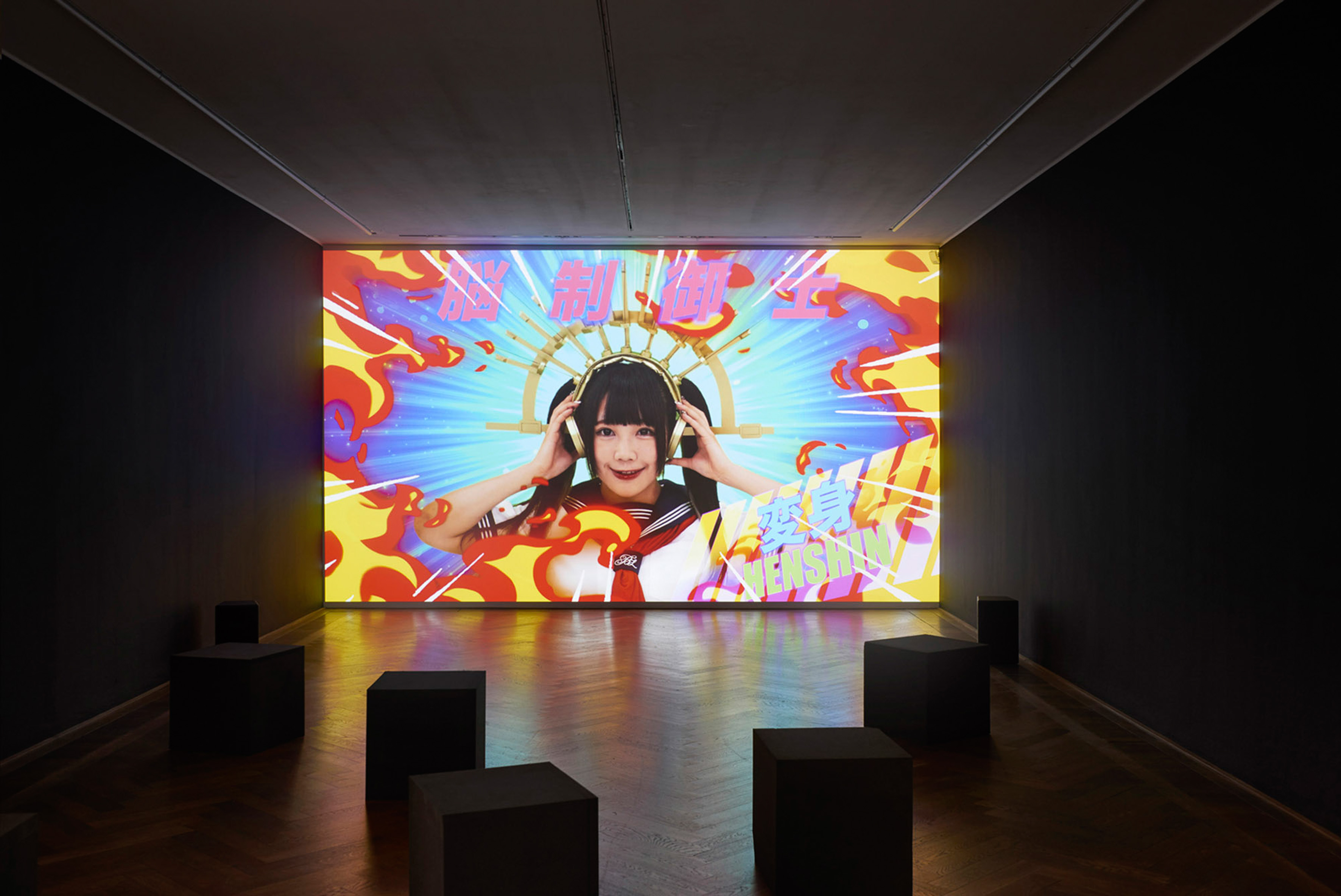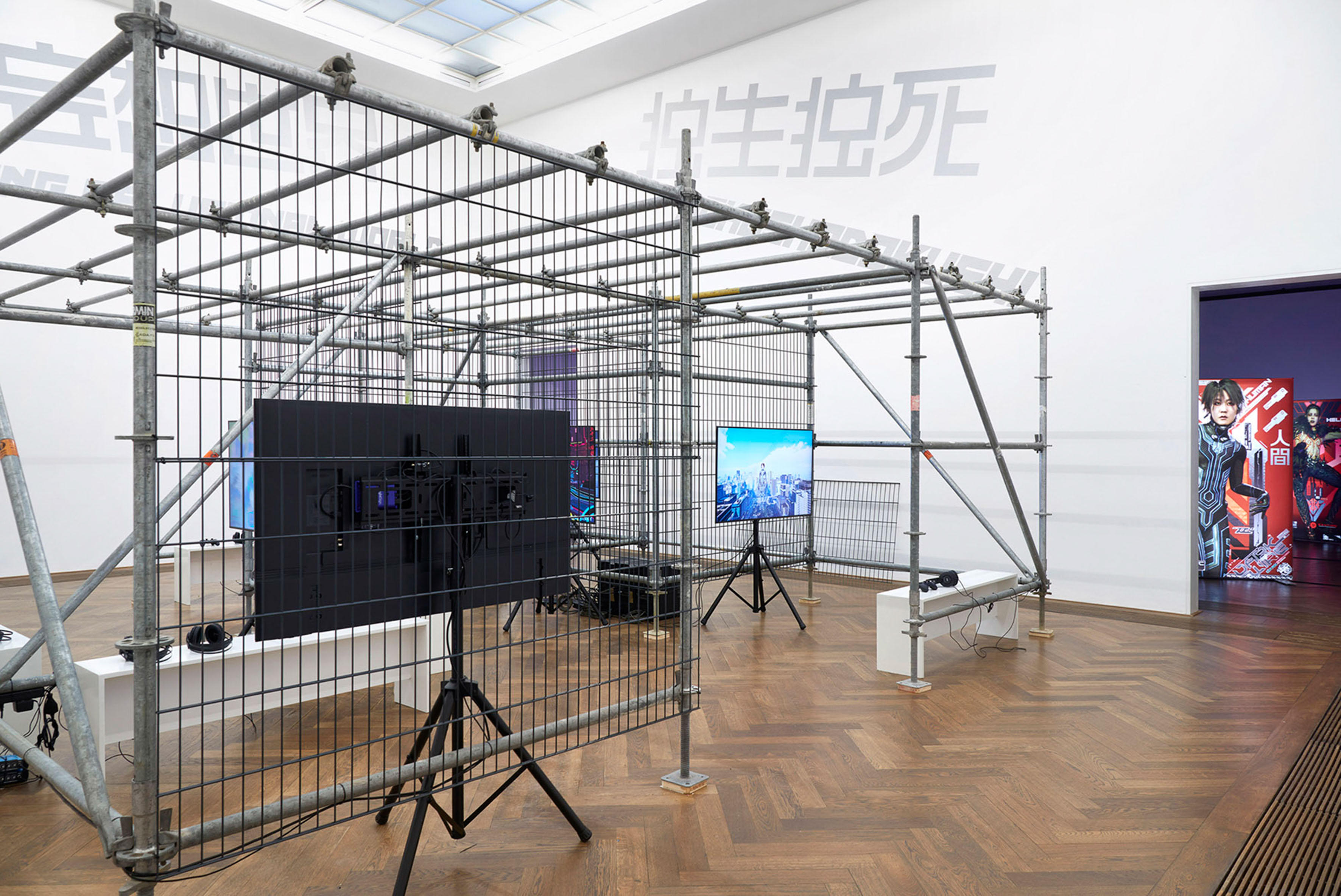YYYYMMDD >>> BACK HOME <<< >>> SELECTED FEATURES <<< >>> HIDDEN ARCHIVE <<<
[20230202]
LuYang VIBRATORY FIELD by LuYang at KUNSTHALLE BASEL [from 20230120 to 20230521]
[Photos: Philipp Hänger /Kunsthalle Basel]












LuYang knows what it is like to die. And to be reborn. In the virtual world, that is. Across a thrillingly hypnotic oeuvre, the Shanghai-born, Tokyo-based artist has already undergone countless digital rebirths, each more spectacular than the previous one. Battling demons, performing acrobatics, being prodded by scientists, saving others, facing demise: the animated figures modeled on LuYang’s face and body are apparently capable of just about anything. His characters—dressed inappropriately wild outfits—in-habit pulsating, maximalist CGI worlds in which the hypermodern and the archaic, apocalypse and redemption meet. The artist’s practice is a persistent investigation, deploying the cultures of anime, video gaming, sci-fi, neuroscience, Buddhism, Indonesian dance rituals, and digital technology in order to mine the mess (and magic) of our mortal condition.
The fact that the human and the digital meet in LuYang’s art is no coincidence: in an era where our lives are infiltrated by technology on an ever more granular level, and the self is propagated in viral proportions on social media, the question of what it means to be human is becoming increasingly fundamental. The artist calls this dilemma nothing less than “the question of all questions.”
LuYang has been wrestling with that question ever since completing his studies in New Media Art at the China Academy of Art in Hangzhou in 2010.
It led him to create a stunningly complex body of works over the last decade that includes 3D animated films, virtual and augmented reality projects, computer games, motion capture performances, installations, and lightboxes. To make them, the artist has worked with a wide range of collaborators, including neuroscientists, pop stars, psychologists, software developers, experimental composers, traditional dancers, poets, robotics companies, philosophers, and science-fiction writers, among others. The results are engrossing and fantastical, techno -psychedelic and sometimes terrifying, united in their attempt to tackle such enormous topics as biology, reincarnation, or even global environmental destruction.
In all of these, as in LuYang’s biography, gender is fluid. So are age, religion, and nationality. Don’t expect to settle the knowledge of which pronouns apply to the artist—these shift in nearly every exhibition handout, article, or interview. And, starting with this exhibition in Basel, the artist’s birth year will be omitted in promotional matter so that he (the pronoun of choice for the moment) approaches ever more accurately the agelessness of his digital avatars.
For LuYang Vibratory Field at Kunsthalle Basel, the artist’s first solo exhibition in Switzerland, nearly every room evokes a different cosmos.
It is as if his 3D animations and computer games spawned the physical environments in which they are nested.
To enter the exhibition is to find oneself in a dimly lit temple of sorts. It is lined with flags and banners in the spirit of a religious festival, with four altars flanking its sides. Each of these serves as a viewing station featuring an individual work made by the artist in the years just after he graduated from art school. And each of these depicts different epic battles between neuroscience and religion—with the titles hinting at their darkly humorous gatherings of “wrathful gods” and “transcranial exorcisms.” Beyond them, and serving as the room’s vibrant centerpiece, is the five- channel video work, Electromagnetic Brainology (2017). It references Buddhist and Hindu teachings on the interconnectedness between the body (and its nervous system) and the four elements. Surrounding the main projection are videos portraying the gods associated with air, earth, fire, and water. They are armed with various medical devices, attempting to restore the well-being of those who have gone through the four forms of universal suffering—birth, aging, illness, and death.
This temple segues into a room rendered as a kind of sci-fi control center, incorporating the three-channel video Material World Knight (2018). A triptych of sorts, it imagines a future where three types of beings have emerged: cloned humans, cyborgs, and AI robots. The trio engages in a philosophical debate about the origins of consciousness, and they ultimately join forces to create a new form of super-hero: Material World Knight.
The screening room beyond features LuYang’s key single-channel video works. From the artist’s bizarre breakout anime superhero film UterusMan (2012—13) to Electromagnetic Brainology Brain Control Messenger (2018), the ensemble bursts with sensory stimuli and draws the viewer into a sugar rush of pulsing color and music in which macabre cyborgs, strange mutants, and the artist’s own head—turned into a giant kite—alternately dance, fight, and carry us with them to alternate realities.
Next is a series of cage-like gaming stations: audiences are invited to adopt characters— from the androgynous UterusMan to the all-powerful World Material Knight—previously encountered in the exhibition. Except now, it is possible to play with them or, as them, explore the universe, acquire energy, or be destroyed, only to be reborn. Yet, in these games, nothing is what it seems. And hell might be around the corner. Even if some boast anime’s candy-colored, fast-paced action, just as many depict creepy scenes in dystopian landscapes. And while some follow the typical role-playing gaming format with narratives geared toward completing “quests,” battling (or ducking) enemies, and achieving “victory,” LuYang uses them all to explore the (sometimes traumatizing) spiritual plane of existence, rather than simply to entertain by way of a competitive, adrenaline-fueled format.
Given that the exhibition transports visitors across worlds, it is perhaps fitting that the final room, in two parts, is modeled on an air-port and airplane. The space features the artist’s most recent exploration of rebirth by introducing DOKU, LuYang’s genderless, digital stand-in. Short for “Dokusho Dokushi,” the character name is a reference to a Buddhist sutra, a canonical scripture, which means: We are born alone, and we die alone.
Lightboxes in the first half of the room, akin to advertising screens like those found in air-ports, present the six digital avatars of DOKU. They suggest reincarnations of the artist in the guise of six virtual proxies inspired by Buddhist and Hindu cosmologies: DOKU Animal, DOKU Asura, DOKU Heaven, DOKU Hell, DOKU Human, and DOKU Hungry Ghost. Each lightbox is titled DOKU PsyFi with the addition of the name of the avatar that is depicted in larger- than-life illuminated form (all 2023) . Stationed like sentries in the air-port’s waiting area, they are accompanied by short videos foregrounding the characters’ special abilities as they dance, move, and shimmy on six screens.
In the second half of the room, the airplane interior area, you encounter the artist’s magisterial narrative film, DOKU the Self (2022). Its creation was no small feat: LuYang traveled to Bali (Indonesia) and Kerala (India) to investigate how dancers of the ritual Balinese Legong and Indian Kathakali dance styles have, for centuries, trained their bodies to move so symmetrically that they appear robotic. Literally embodying the idea of humanity’s ancient longing to escape mortality, these dance traditions inspired LuYang’s various exuberant DOKU films in which ancient choreographies meet cutting- edge computer-generated technologies. To make the videos, motion capture cameras record the gestures of different dancers, each of which has been equipped with markers attached to their bodies. These recordings were combined with the artist’s own facial expressions, documented using specialized software and high-precision 3D scanners. The result is projected onto a large screen framed by rows of airplane seats, conveying the story of DOKU. Summoned from the artist’s memory and lived experience of narrowly escaping an airplane crash while traveling amid the pandemic, the video con – jures DOKU as seated on a passenger airplane, moving between dream states and paranoia as the world crumbles and doom looms all around. In the process of this transcendental voyage, he reincarnates into his six avatars.
From the temple to the airport, the different spaces of the exhibition are testimony to LuYang’s wildly frenetic imagination. Winner of the 2022 Deutsche Bank “Artist of the Year” award, his world-building proves to be as much virtual as physical. In the exhibition— one of the most comprehensive presentations of this artist’s production of the past decade—visitors experience an immersive journey into the persistent themes driving LuYang’s practice. The works’ humor, depth, and singular magnetism open doors to worlds (and the concerns that accompany them) that may look terrifying and strange but also, at times, not so far from our own.
LuYang was born in Shanghai, CN; lives and works in Tokyo
[Text: Kunsthalle Basel]
©YYYYMMDD All content and design by Daniela Grabosch + Ricardo Almeida Roque unless otherwise stated. Images, Videos and Texts can only be used under permission of the author(s).